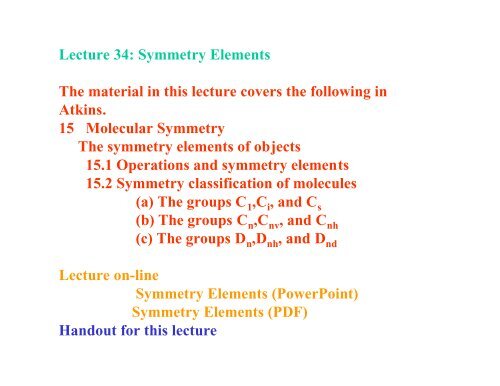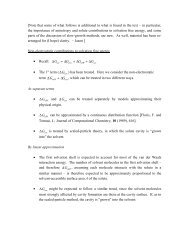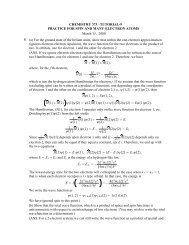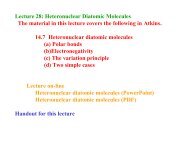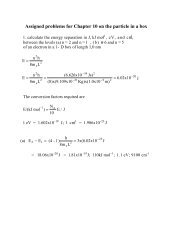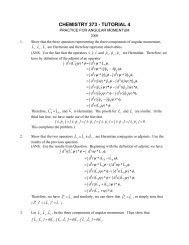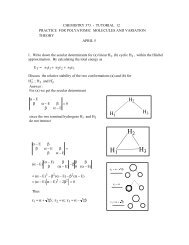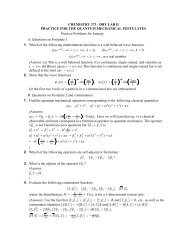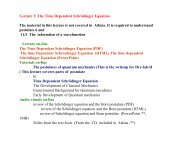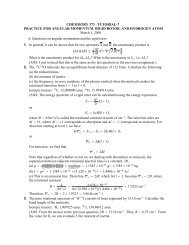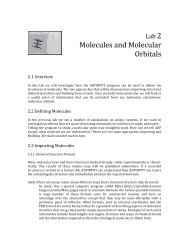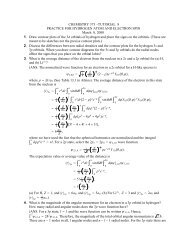Lecture 34: Symmetry Elements The material in this lecture ... - Cobalt
Lecture 34: Symmetry Elements The material in this lecture ... - Cobalt
Lecture 34: Symmetry Elements The material in this lecture ... - Cobalt
Create successful ePaper yourself
Turn your PDF publications into a flip-book with our unique Google optimized e-Paper software.
<strong>Lecture</strong> <strong>34</strong>: <strong>Symmetry</strong> <strong>Elements</strong><br />
<strong>The</strong> <strong>material</strong> <strong>in</strong> <strong>this</strong> <strong>lecture</strong> covers the follow<strong>in</strong>g <strong>in</strong><br />
Atk<strong>in</strong>s.<br />
15 Molecular <strong>Symmetry</strong><br />
<strong>The</strong> symmetry elements of objects<br />
15.1 Operations and symmetry elements<br />
15.2 <strong>Symmetry</strong> classification of molecules<br />
(a) <strong>The</strong> groups C 1 ,C i , and C s<br />
(b) <strong>The</strong> groups C n ,C nv , and C nh<br />
(c) <strong>The</strong> groups D n ,D nh , and D nd<br />
<strong>Lecture</strong> on-l<strong>in</strong>e<br />
<strong>Symmetry</strong> <strong>Elements</strong> (PowerPo<strong>in</strong>t)<br />
<strong>Symmetry</strong> <strong>Elements</strong> (PDF)<br />
Handout for <strong>this</strong> <strong>lecture</strong>
<strong>Symmetry</strong> elements<br />
<strong>The</strong> systematic discussion of<br />
symmetry is called<br />
Some objects are more<br />
symmetrical than others<br />
Any rotation of sphere<br />
around axis through<br />
center br<strong>in</strong>gs sphere<br />
over <strong>in</strong>to itself<br />
Some of the symmetry elements of a cube.<br />
<strong>The</strong> twofold, threefold, and fourfold axes<br />
are labelled with the conventional symbols.<br />
Only some rotations of sphere<br />
br<strong>in</strong>gs cube <strong>in</strong>to itself
<strong>Symmetry</strong> elements<br />
(a) An NH 3 molecule has a<br />
threefold (C 3 ) axis<br />
(b) an H 2 O<br />
molecule has a twofold (C 2 ) axis.<br />
Both have other symmetry<br />
elements too.<br />
NH3 has more rotation<br />
symmetry than H 2 O
<strong>Symmetry</strong> elements<br />
An action that leaves an object the same after<br />
it has been carried out is called a :<br />
<strong>Symmetry</strong> operations are :<br />
For each symmetry operation there is a :<br />
symmetry element<br />
Which is<br />
with respect to which the operation is performed
Operators<br />
and <strong>Symmetry</strong> elements<br />
<strong>The</strong> classification of objects accord<strong>in</strong>g to<br />
symmetry elements corrspond<strong>in</strong>g to<br />
operations that leave at least one common<br />
po<strong>in</strong>t unchanged gives rise to the :<br />
<strong>The</strong>re are five k<strong>in</strong>ds of symmetry<br />
operations and correspond<strong>in</strong>g<br />
symmetry elements<br />
1. <strong>The</strong> identity E Consists of do<strong>in</strong>g noth<strong>in</strong>g<br />
Cl<br />
I<br />
F<br />
Br<br />
Only element for CFClBrI
Operators<br />
and <strong>Symmetry</strong> elements<br />
C 3 and C<br />
3 -1<br />
C 6<br />
C ; C ; C<br />
and C ; C<br />
(b) an H2O<br />
molecule has a twofold (C2) axis.<br />
6 3 2<br />
6 -1 3 -1 <strong>The</strong> pr<strong>in</strong>ciple rotation axis<br />
is the axis of the higest fold<br />
C 5
Operators<br />
and <strong>Symmetry</strong> elements<br />
<strong>The</strong> H 2O<br />
molecule<br />
has two mirror<br />
planes. <strong>The</strong>y are<br />
both vertical<br />
(that is conta<strong>in</strong><br />
the vertical axis)<br />
and as so are<br />
denoted<br />
σ and σ '<br />
v<br />
v
C 6<br />
Dihedral mirror planes ( bisect<br />
Operators<br />
and <strong>Symmetry</strong> elements<br />
C 2<br />
C 2<br />
C 2<br />
Benzene has one<br />
mirror plane<br />
perpendicular<br />
to the pr<strong>in</strong>ciple<br />
C6 - axis ( σ h)<br />
σ d)<br />
the C 2 axis perpendicular to the<br />
pr<strong>in</strong>ciple axis
Operators<br />
and <strong>Symmetry</strong> elements<br />
A regular octahedron has a centre of <strong>in</strong>version (i).
Operators<br />
and <strong>Symmetry</strong> elements<br />
(a). A CH 4 molecule<br />
has a fourfold improper<br />
rotation axis (S 4 ):<br />
the molecule is <strong>in</strong>dist<strong>in</strong>guishable<br />
after a 90° rotation followed by<br />
a reflection across the horizontal<br />
plane, but neither operation<br />
alone is a symmetry operation.<br />
C 4<br />
σ
Operators<br />
and <strong>Symmetry</strong> elements<br />
(b) <strong>The</strong> staggered form of<br />
ethane has an S 6 axis<br />
composed of a 60°<br />
rotation followed by<br />
a reflection.
<strong>The</strong> <strong>Symmetry</strong> Classification of Molecules<br />
<strong>The</strong> Schoenflies system<br />
Hermann − Maugu<strong>in</strong>
<strong>The</strong> <strong>Symmetry</strong> Classification of Molecules<br />
C , C , C 1 i s<br />
<strong>The</strong> groups C , C , C 1 i s<br />
F<br />
A molecule belongs to C if it<br />
has only the identitity E 1<br />
Cl<br />
I<br />
Br<br />
COOH<br />
HO<br />
H<br />
A molecule belongs to C i if it<br />
has only the identitity E and i<br />
H<br />
HOOC<br />
OH<br />
Meso-tartaric<br />
acid<br />
A molecule belongs to Cs if it<br />
has only the identity and a mirror<br />
plane<br />
N<br />
Qu<strong>in</strong>ol<strong>in</strong>e
<strong>The</strong> <strong>Symmetry</strong> Classification of Molecules C n<br />
<strong>The</strong> groups C n,<br />
C nv , and C nh<br />
A molecule belongs to C n if it<br />
has a C n axis and the identitity E only<br />
C C C<br />
4 5 6<br />
C 2 C 3<br />
C 2<br />
H<br />
O<br />
O<br />
H<br />
H 2 O 2
<strong>The</strong> <strong>Symmetry</strong> Classification of Molecules<br />
<strong>The</strong> groups C n,<br />
C nv , and C nh<br />
A molecule belongs to C nv if it<br />
has a C n axis and n vertical<br />
mirror planes<br />
C nv<br />
cone<br />
C<br />
C C 4v<br />
C 5v<br />
C6v<br />
C ∞v<br />
2v<br />
3v<br />
NH 3<br />
C 3v<br />
H 2 O C2v<br />
CO<br />
Heteronuclear<br />
diatomics are<br />
C ∞v
<strong>The</strong> <strong>Symmetry</strong> Classification of Molecules<br />
<strong>The</strong> groups C n,<br />
C nv , and C nh<br />
A molecule belongs to C nh if it<br />
has a C n axis and a horizontal<br />
mirror plane<br />
C nh<br />
C 2h<br />
C 3h<br />
C 4h<br />
C C 5h<br />
6h<br />
Cl<br />
C<br />
H<br />
O<br />
H<br />
C<br />
H Cl<br />
Trans CHCl=CHCl<br />
H<br />
O<br />
B<br />
O<br />
H<br />
B(OH) 3
<strong>The</strong> <strong>Symmetry</strong> Classification of Molecules<br />
<strong>The</strong> groups C n,<br />
C nv , and C nh<br />
C nh<br />
C 2<br />
σ<br />
i<br />
<strong>The</strong> presence of a twofold axis and a horizontal mirror plane<br />
jo<strong>in</strong>tly imply the presence of a centre of <strong>in</strong>version <strong>in</strong> the<br />
molecule.
<strong>The</strong> <strong>Symmetry</strong> Classification of Molecules<br />
D n<br />
<strong>The</strong> groups D n,<br />
D nv , and D nh<br />
A molecule belongs to D n if it<br />
has a C n axis and n two fold axes<br />
(C ) perpendicular to C .<br />
2 n<br />
N<br />
Pt<br />
N<br />
N<br />
N<br />
N<br />
D 3<br />
N<br />
A molecule with n twofold rotation axes perpendicular to an<br />
n-fold rotation axis belongs to the group Dn.
<strong>The</strong> <strong>Symmetry</strong> Classification of Molecules<br />
<strong>The</strong> groups D n,<br />
D nv , and D nh<br />
D 2 D3<br />
D 4 D5 D 6<br />
D n
<strong>The</strong> <strong>Symmetry</strong> Classification of Molecules<br />
<strong>The</strong> groups D , D , and D<br />
A molecule belongs to D nh if it<br />
has a C n axis and n two fold axes<br />
(C 2) perpendicular to C n as well as<br />
a horizontal mirror plane.<br />
n nv nh<br />
D nh<br />
A molecule<br />
with a<br />
Mirror plane<br />
perpendicular<br />
to a C n axis,<br />
and with n<br />
twofold axes <strong>in</strong><br />
the plane, belongs<br />
to the group<br />
D nh .
<strong>The</strong> <strong>Symmetry</strong> Classification of Molecules<br />
<strong>The</strong> groups D , D , and D<br />
n nv nh<br />
A molecule belongs to D nh if it<br />
has a C n axis and n two fold axes<br />
(C 2) perpendicular to C n as well as<br />
a horizontal mirror plane.<br />
D 2h<br />
D 3h<br />
D 4h<br />
D 5h<br />
D h<br />
D nh<br />
C 2<br />
H H<br />
C<br />
σ h<br />
6<br />
C 2<br />
C<br />
C 4<br />
H H D 2h<br />
C 4<br />
C 2<br />
Cl<br />
Cl<br />
σ h Au<br />
C'<br />
Cl<br />
Cl<br />
2<br />
C 2<br />
D 4h C 2
<strong>The</strong> <strong>Symmetry</strong> Classification of Molecules<br />
<strong>The</strong> groups D , D , and D<br />
A molecule belongs to D nh if it<br />
has a C n axis and n two fold axes<br />
(C 2) perpendicular to C n as well as<br />
a horizontal mirror plane.<br />
n nv nh<br />
F<br />
B<br />
D nh<br />
F<br />
F<br />
E , C 3, 3C 2 , σh<br />
E , C 6, 3C 2 ,3C' 2, σh
<strong>The</strong> <strong>Symmetry</strong> Classification of Molecules<br />
<strong>The</strong> groups D n,<br />
D nv , and D nh<br />
D nh<br />
F<br />
σ h<br />
C 3<br />
C 2<br />
C 2<br />
F<br />
C 2<br />
F<br />
P<br />
F<br />
F<br />
D 3h
<strong>The</strong> <strong>Symmetry</strong> Classification of Molecules<br />
<strong>The</strong> groups D , D , and D<br />
A molecule belongs to D nd if<br />
<strong>in</strong> addition to the elements of<br />
D n it posesses n dihedral mirror<br />
planes<br />
n nv nh<br />
D nd<br />
D 2d<br />
D 3d<br />
D 4d<br />
D 5d<br />
D 6d<br />
C 2<br />
C 2<br />
C C C C 2<br />
D 2d
What you must learn from <strong>this</strong> <strong>lecture</strong><br />
1. Given a molecule, you should be able to identify the different<br />
symmetry elements (C n ,σ v ,σ h ,σ d ,i,S n , etc. )<br />
2. Hav<strong>in</strong>g identified the symmetry elements of a molecule,<br />
you should be able to establish the po<strong>in</strong>t group to which<br />
the molecule belong


